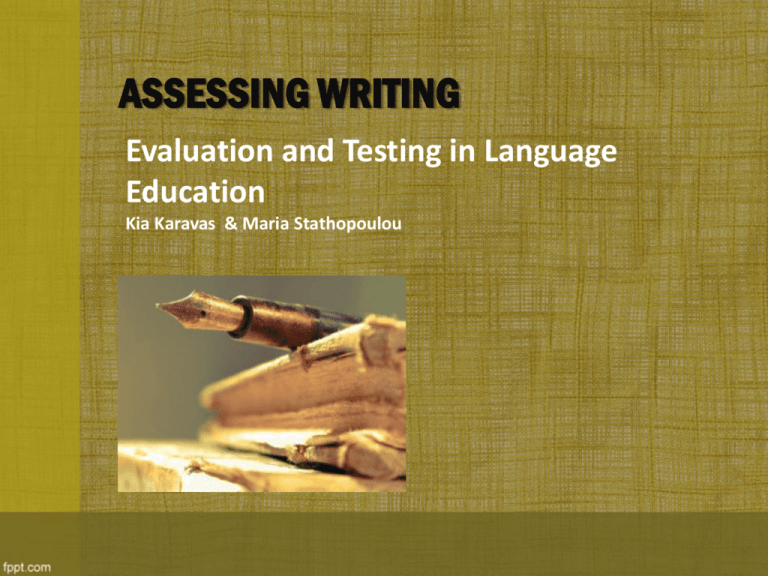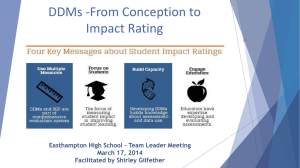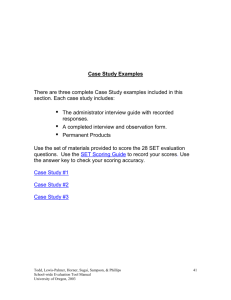Assessing writing
advertisement

ASSESSING WRITING Evaluation and Testing in Language Education Kia Karavas & Maria Stathopoulou Aims of the presentation • to familiarize students with concepts related to the assessment of writing (performance based assessment, classroom based assessment, rating process, raters, evaluation criteria & grids) • to distinguish between different types of assessment tasks • to design their own tasks for assessing written performance The nature of writing ability • Defining the skill we wish to test is a critical starting point in designing a test What is writing?…an act which takes place within a context writing is a social act (socially and culturally shaped) The purpose or function of the writing is defined by the context. This means that the features of the text may differ according to purpose Learning to write is much more than simply learning the grammar and vocabulary of a language What is writing?…a cognitive activity • Encoding internal representations (ideas) into written text What is a (written) text? • Texts are shaped by the social and cultural contexts in which they are produced. Text producers are influenced by a number of interrelated variables that define and characterize these contexts a. purpose b. text-type c. subject matter / topic d. role or perspective taken by the text producer e. relationship with the intended audience f. intended impact on the audience g. medium through which the communication is undertaken . Knapp, P. and Watkins, M. 2005. Genre, text, grammar: Technologies for teaching and assessing writing. Sydney: UNSW Press. Writing and foreign language teaching & testing Teaching writing Assessing writing Writing and foreign language teaching & testing Teaching writing Assessing writing Assessing writing skills through: i. ii. Classroom based assessment Performance assessment through examination batteries Achieving validity in writing assessment • Validity refers to whether the test actually measures what it is supposed to measure • If a test has content validity, we have enough language to make a judgement about the student’s ability. So if a writing test is to have content validity, we need to be confident we have asked the student to do enough writing to display their writing skills INSTRUMENT: Designing writing tests & tasks a) Test purpose (test specifications and can-do statements, target population) c) Task characteristics Test paper Task a1) Specifications • Test level • Description of the test content (number of activities, types of activities, types of texts) • Criteria for evaluation KPG specifications http://rcel.enl.uoa.gr/kpg a2) Can-do statements What types of skills and competences are assessed at each level? EPS-XG , C1 level http://rcel.enl.uoa.gr/xenesglosses b) Task design: basic considerations (1) Type of task: Controlled, guided or semi-guided? Topics Text type and function Time allotment Rubrics (or instructions): specify how the test taker is expected to perform Stimulus material (visual, writing prompt): the stimulus the student must respond to. b) Task design: basic considerations (2) • Expected response: what the teacher intends students to do with the task. • Post-task evaluation: assessing the effectiveness of the assessment task: o Did the task discriminate well among the student group? o Were the products easy to read and evaluate? o Were students able to write to their potential? Adapted from Reid and Kroll (1995: 35) Guidelines for the preparation of effective writing tasks The content should be accessible to students, feasible given their knowledge and abilities The language used should be unambiguous and comprehensible. The task should be sufficiently focused to allow for completion in the given time and length. The task should draw on and extend students’ knowledge of the genre and the topic. The task should require a specific and relevant genre and indicate a specific audience. There should be clear evaluation criteria so that students know how their work will be assessed Reid and Kroll (1995) How to select texts for writing tasks? o Texts should come from a wide variety of sources and discourse environments (articles, letters and emails, informative texts from different types of leaflets, instruction-manual texts, maps with commentaries, lyrics, book announcements, webpage texts, etc. o should be close to students’ interests and needs Avoid texts: with ‘sensitive’ issues, such as a description of a fatal accident, with comments that might be perceived as politically incorrect or offensive which stereotype ethnic groups and promote values of ethnicism, sexism, nationalism, linguicism, etc. that are not well written, confusing, or incoherent that outline many different basic subjects without focusing on something specific are written in language that is either too difficult or too easy, are too long and would require too much processing FROM TASK DESIGN TO THE RATING PROCESS: ASPECTS OF RATING ‘reliability refers to the consistency with which a sample of student writing is assigned the same rank or score after multiple ratings by trained evaluators’ (Ferris & Hedgcock 1998: 230) For example: if we’re marking an essay out of 20, the test will be far more reliable if 2 markers both award an essay the same grade (or more or less the same grade), say 16 or 17. However, if 1 marker awards 10 and the other awards 15, the test isn’t reliable. The obvious way to try to achieve reliability is by designing criteria (e.g. for content, organization, grammar, etc.) which the markers refer to when they’re marking the essay From task design to the rating process: aspects of rating o Rating scale & grading o Rating process o Rating conditions (setting, pen-andpaper vs. electronic tests, time) o Rater characteristics o Rater training (Weir 2005) RATING SCALES A rating scale is a set of categories designed to elicit information about an attribute Evaluation criteria Descriptor Holistic scoring • Holistic scoring means that the assessor assesses the text generally, rather than focusing on 2 or 3 specific aspects • The idea is that the assessor quickly reads through a text, gets a global impression, and awards a grade accordingly • The holistic approach is supposed to respond to the writing positively, rather than negatively focusing on the things the writer has failed to do Types of scales: Holistic scoring Intermediate learners, Hyland, 2003: 228 Holistic scoring is… • Quick and easy, because there are few categories for the teacher to choose from • BUT • can’t provide the writing teacher with diagnostic information about students’ writing, because it doesn’t focus on tangible aspects of writing (e.g. organization, grammar, etc.) A single score can be difficult to interpret for both teachers and students (‘What does 70% actually mean?’ ‘What did I do well?’ ‘What did I do badly?’) Holistic scoring • Even though assessors are supposed to assess a range of features in holistic scoring (e.g. style, content, organization, grammar, spelling, punctuation, etc.), this isn’t easy to do. So some assessors may (consciously or unconsciously) value 1 or 2 of these criteria as more important than the others, and give more weighting to these in their scores (Lumley & McNamara 1995; McNamara 1996). Analytic scoring • Analytic scoring separates different aspects of writing (e.g. organization, ideas, spelling) and grades them separately Analytic scoring Analytic schemes provide learners with much more meaningful feedback than holistic schemes. Teachers can hand students’ essays back with the criteria (e.g. marks out of 10 for organization, spelling, etc.) circled which the writing was awarded Analytic schemes can be designed to reflect the priorities of the writing course. So, for instance, if you have stressed the value of good organization on your course, you can weight the analytic criteria so that organization is worth 60% of the marks Analytic scoring Because assessors are assessing specific criteria, it’s easier to train them than assessors who are using holistic schemes (Cohen 1994; McNamara 1996; Omaggio Hadley 1993; Weir 1990) Analytic assessment is more dependable than holistic assessment (Jonsson & Svingby, 2007: 135) Disadvantages of analytic scoring • Each of the scales may not be used separately (even though they should be). So, for instance, if the assessor gives a student a very high mark for the ‘ideas’ scale, this may influence the rest of the marks they award the student on the other scales • Descriptors for each scale may be difficult to use (e.g. ‘What does ‘adequate organization’ mean?’) Types of scales: Analytic scoring KPG exams, B level Developing evaluation criteria The description of tasks in terms of their characteristics and requirements is an important aspect when it comes to develop evaluation criteria or to mark learners’ scripts Task characteristics (text length, time constraints etc) TASK Performance Evaluation criteria Task requirements (what learners/candidates are expected to do) An example of task expectations • You are an advice columnist in an e-newspaper addressed to teens. Write an answer to a young man (“The Loner”), who asked for help because he is constantly arguing with his father, who keeps telling him to go out and make friends. The “loner” tells you he’s perfectly happy surfing the net, studying, speaking to imaginary friends…! In your advice letter, explain why friends are very important for young people, using the clues below (100 words). • • • • • CLUES Feel accepted Someone to confide in Share experiences/things Someone to count on for advice Expectations regarding output • • • • Criterion 1: Task Completion Assuming the role of an advice columnist, candidates are expected to produce an advice letter (genre), responding to a young man (“The Loner”), who has asked for advice given that he is in bad terms with his father, who is always trying to get him to go out and be with friends, rather than stay home all day and surf the net. In the letter, they may try to explain to “the Loner” why it is important for young people to make friends. Although they are asked to use the clues provided, they may also include their own ideas regarding this topic. The tone of their scripts should be personal and direct (register & style). Criterion 2: Text Grammar Candidates’ scripts are expected to have the main body, an opening and a closing remark in one or two paragraphs. A concluding remark encouraging the addressee to go out and make friends is ideally expected. Ideas among paragraphs should be cohesively and coherently linked. A few simple and appropriate linking devices within and across sentences are expected. Expectations regarding output • Criterion 3: Sentence Grammar • The choice of vocabulary and grammar should be conducive to the communicative purpose of the text. Candidates are expected to use argumentative language since they have to try to convince the young man that going out with friends spending is far better than spending time alone at home(e.g., one reason why we need friends….). Expressions appropriate to giving advice (It is important that…, you should..,) are also expected, as well as simple grammatical structures (most likely referring to the present). • Classroom based assessment: some basic considerations ongoing or final? In-class or out-of-class? Focused on writing as an independent language skill or integrated with other language tasks? Grading on analytic or holistic scales? » Dr Maria Stathopoulou mastathop@enl.uoa.gr




